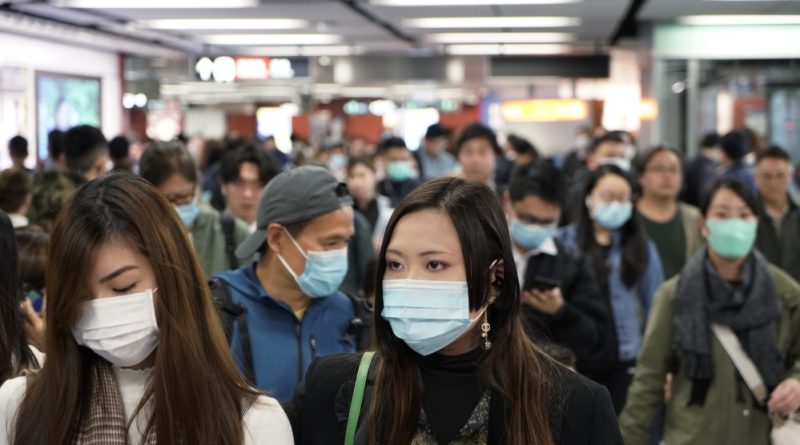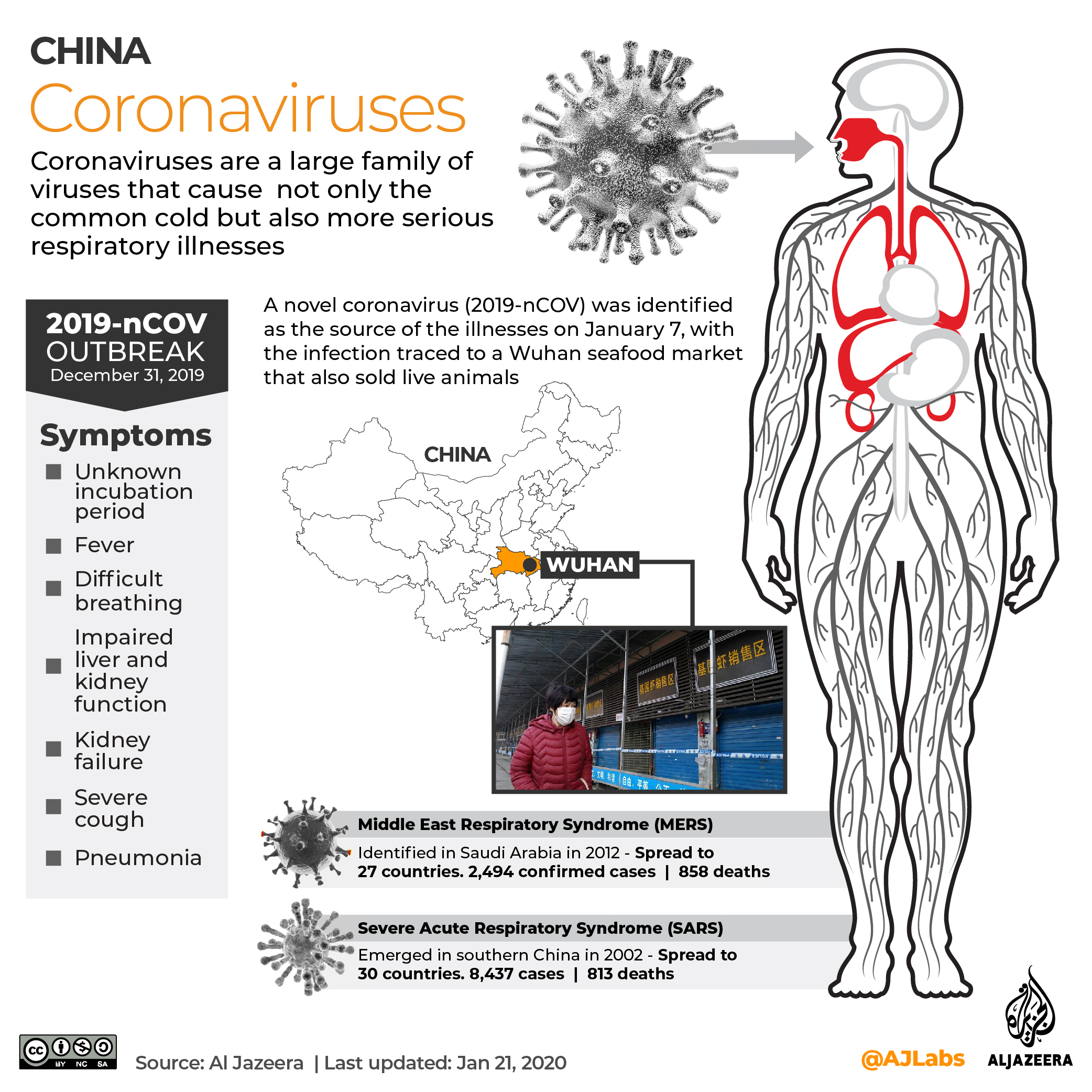Timeline: How China’s new coronavirus spread | China News
The World Health Organization (WHO) has declared a global health emergency over a new coronavirus that has killed at least 722 people in mainland China, with cases confirmed in the Asia-Pacific region, Europe, North America and the Middle East.
Below is a timeline.
More:
On December 31 last year, China alerted WHO to several cases of pneumonia in Wuhan, a port city of 11 million people in the central Hubei province. The virus is unknown.
Several of those infected worked at the city’s Huanan Seafood Wholesale Market, which was shut down on January 1.
As health experts worked to identify the virus amid growing alarm, the number of infections exceeded 40.
On January 5, Chinese officials ruled out the possibility that this was a recurrence of the severe acute respiratory syndrome (SARS) virus – an illness that originated in China and killed more than 770 people worldwide in 2002-2003.
On January 7, they announced they had identified a new virus, according to the WHO. The novel virus was named 2019-nCoV and was identified as belonging to the coronavirus family, which includes SARS and the common cold. Coronaviruses are common and spread through being in proximity to an infected person and inhaling droplets generated when they cough or sneeze or touching a surface where these droplets landed and then touching one’s face or nose.
On January 11, China announced its first death from the virus, a 61-year-old man who had purchased goods from the seafood market. Treatment did not improve his symptoms after he was admitted to hospital and he died on the evening of January 9 when his heart failed.
On January 13, the WHO reported a case in Thailand, the first outside of China, a woman who had arrived from Wuhan.
On January 16, Japan’s health ministry reported a confirmed case in a man who had also visited the city.
On January 17, as a second death was reported in Wuhan, health authorities in the United States announced that three airports would start screening passengers arriving from the city.
Authorities in the US, Nepal, France, Australia, Malaysia, Singapore, South Korea, Vietnam and Taiwan confirmed cases over the following days.
On January 20, China reported a third death and more than 200 infections, with cases also reported outside Hubei province including in the capital, Beijing, Shanghai and Shenzhen.
Meanwhile, a Chinese expert on infectious diseases confirmed human-to-human transmission to state broadcaster CCTV, raising fears of a major outbreak as millions travel for the Lunar New Year holiday.
Asian countries ramped up measures to block the spread of the virus, introducing mandatory screenings at airports of all arrivals from high-risk areas of China.
On January 22, the death toll in China jumped to 17 with more than 550 infections. Many European airports stepped up checks on flights from Wuhan.
Wuhan was placed under effective quarantine on January 23 as air and rail departures were suspended.
The same measures were announced for two more cities in Hubei province: Xiantao and Chibi.
Beijing cancelled events for the Lunar New Year, starting on January 25, while officials reported the first death outside of Hubei.
The WHO said later on January 23 that the outbreak does not yet constitute a public emergency of international concern and there is “no evidence” at the moment of the virus spreading between humans outside of China.
By January 24, the death toll in China stood at 26, with the government reporting more than 830 infections.
The number of cities under lockdown in Hubei rose to 13, affecting 41 million people.
Shanghai Disneyland shut down and some other cities announced the closure of entertainment venues. Beijing said a section of the Great Wall and other famous landmarks would also be closed.
On January 25, travel restrictions were imposed on a further five cities in Hubei province, taking the overall number of people affected to 56 million.
Hong Kong meanwhile declared a virus emergency, cancelled Lunar New Year celebrations and restricted links to mainland China.
On January 26, the death toll rose to 56, with almost 2,000 cases confirmed as travel restrictions were increased and Hong Kong closed its Disneyland and Ocean Park theme parks.
New cases were confirmed in the US, Taiwan, Thailand, Japan and South Korea.
As of January 27, the death toll in China rose to 106, with 100 in Hubei province, authorities reported. Another 4,515 people in China were reported to be infected. There were 2,714 confirmed cases in Hubei province, up from 1,423 the day before.
On January 30, the WHO declared coronavirus a global emergency as the death toll in China jumped to 170, with 7,711 cases reported in the country, where the virus has now spread to each of the 31 provinces.
India and the Philippines confirmed their first cases of the virus, with one infected patient in each country.
On January 31, the number of confirmed cases in China jumped to 9,809. Russia, Spain, Sweden and the United Kingdom confirmed their first cases of the virus.
On February 1, the death toll in China rose to 259, with 11,791 confirmed infections in the country, according to new figures released by the Chinese health authority.
New cases were confirmed in Australia, Canada, Germany, Japan, Singapore, the US, the United Arab Emirates (UAE) and Vietnam.
As of February 2, the first death outside of China was reported in the Philippines. The patient was a Chinese man from Wuhan.
The death toll in China rose to 304, with 14,380 infections reported.
On February 3, China reported 57 new fatalities, bringing its death toll to at least 361. The number of cases rose to 17,205 people across the country.
On February 4, China said the death toll rose to 425 people and the number of infected people stood at 20,438 in the mainland. Hong Kong also reported one death, bringing the global fatalities to 427. The first case was confirmed in Belgium in a person who was repatriated from Wuhan.
As of February 5, more flights evacuating US citizens returned from Wuhan and the WHO reaffirmed there was “no known effective treatment” for the coronavirus.
Meanwhile, China reported 490 deaths and 24,324 cases of infection.
On February 6, the death toll in mainland China rose to at least 563, with more than 28,000 cases confirmed.
Meanwhile, authorities in Malaysia reported the country’s first known human-to-human transmission and the number of people infected in Europe reached 30.
On February 7, Li Wenliang, a doctor who was among the first to sound the alarm over the coronavirus, died, and Hong Kong introduced prison sentences for anyone breaching quaratine rules.
Mainland China confirmed the death toll had reached at least 636, with 31,161 cases of infection and Chinese researchers suggested the pangolin may have been one link in the chain of animal-human infections.
On February 8, a US citizen died in Wuhan in what appears to be the first confirmed foreign death from the coronavirus outbreak.
The death toll in China reached 722, while the number of confirmed infections are 34,546.



![[Al Jazeera] Coronavirus: 2019-NCoV vaccine](https://www.aljazeera.com/mritems/Images/2020/2/1/b1367bfb2e7545b7bad603998a8143ae_18.jpg)